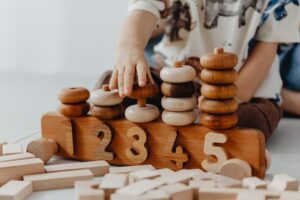6 Exciting Number Activities for Preschoolers & Kindergarteners
Introducing numbers to preschoolers and kindergarteners doesn’t have to be a boring task. In fact, there are plenty of exciting and engaging activities that can help your little ones learn identifying & counting numbers. These 7 number recognition activities for preschool will help your kindergartener get a head start in their numeracy skills.
1. Counting Songs and Rhymes
Counting songs and rhymes are a great way to introduce numbers to young children. Even before they can count, preschoolers can recognize and enjoy familiar counting songs. Counting songs help to make the concepts of numbers more concrete and memorable for children.
Start with simple counting songs like “One, Two, Buckle My Shoe” and “Ten in the Bed.” As your child becomes more comfortable with counting, you can move on to more complex songs that involve addition or multiplication. You could also make up your own songs or rhymes to emphasize a specific concept like odd numbers or even numbers.
2. Number Recognition Games
When it comes to teaching young kids about numbers, fun games can go a long way. Playing number recognition games is an engaging way for preschoolers and kindergartners to learn and practice recognizing numbers. Here are a few ideas:
i. Number Puzzles
Puzzles with numbers can provide a fun challenge for preschoolers and kindergarteners. Choose puzzles with big pieces, so they’re easy to handle.
ii. Number Memory
Make a memory game using pairs of cards with different numbers written on them. This game encourages your child to recognize the written numerals and remember where each card is located.
These number recognition games provide lots of fun for kids while helping them learn to identify numerals and associate them with different quantities.
3. One-to-one Correspondence Activities

One-to-one correspondence activities help young children develop number sense and counting skills. They involve connecting a number with an object or group of objects that represent the same quantity. This type of number activity is important because it helps children understand the concept of numerals and the fact that each number represents an amount.
Here are some great one-to-one correspondence activities for preschoolers and kindergarteners:
A. Number Matching Game
Cut out numbers from cardboard or paper and have your child match the numeral to the corresponding number of objects. For example, provide 5 cars for them to match the numeral “5”.
B. Matching Sock Pairs
Count how many pairs of socks are in a pile. Then have your child find the corresponding number of socks in the pile and match them into pairs.
4. Connecting Numbers to Quantities
This is a crucial concept that preschoolers and kindergarteners need to understand in order to build their math skills. One way to help children understand this concept is to provide activities that help them explore the relationship between numbers and objects.
Play a memory game. Place sets of objects (at least five) on a table, and have your child count them aloud. Then cover the objects with an opaque container or a cloth, and ask your child to remember how many there were and write down the corresponding numeral.
5. Numeral Formation Games
Introducing preschoolers and kindergartners to the written representation of numbers is an important math concept for them to learn. Numeral formation games can be a fun and engaging way to help children become more familiar with written numerals.
One popular numeral formation game is called “What Number Am I?” Draw numerals 0-9 on flashcards, one numeral per card. Show the cards in random order and ask your child, “What number am I?” If they get stuck, give them clues such as counting up from the last number, or saying the sound of the numeral (e.g., “buh” for 2).
6. Storytelling with Numbers
Storytelling with numbers is a great way to help preschoolers and kindergarteners learn to identify and understand numbers. This activity can be done in many different ways. Here are a few ideas:
- Ask the child to choose their favorite number, then create a story together around that number. For example, if they choose the number 5, you could tell them the story of a family of five who lives in a magical kingdom.
- Give the child a set of number cards and ask them to arrange them in order from smallest to largest. Then, create a story where each number plays an important role. For instance, in the story, five cats jump over a fence one by one, and ten sheep escape from the farm into the wild.
- Create stories based on counting. Ask the child to count up from 1 to 10 (or higher), then tell a story about what happens at each number. For example, when the child counts to three, a magical door opens and when they count to five, five flying horses appear.
Conclusion
Number recognition activities for preschool and kindergarten can be great tools for helping young children learn essential mathematical concepts. By providing these opportunities for students to practice and explore numbers, educators can help foster a strong foundation for later math success. So why not try out some of these exciting number-based activities with your students today?





